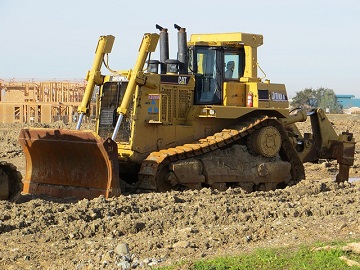Earthworks
The term ‘earthworks’ refers to the removal or placement of soils and other excavated material during construction. This is commonly part of civil engineering works required in the construction of roads, railways, land stabilisation, and land grading to change the topography of a site.
Earthworks: a guide, Second edition, by Paul Nowak and Peter Gilbert, Published by ICE in 2015 states: ‘Earthworks operations include the excavation, transport, placement and compaction of fill materials to construct earth structures, and is a significant element of almost all civil engineering projects. A good understanding of earthworks design and construction enables the delivery of successful projects and avoidance of costly problems.’
Earthwork is one of the earliest and most significant works in the construction process. It involves the removal of topsoil and other material, along with any vegetation, before scraping and grading the area to the finished ‘formation level’. This is usually done using a tractor shovel, grader or bulldozer. Below the formation level, the soil is known as the ‘subgrade’.
Most earthworks are formed by cut-and-fill, and the type of ‘fill’ material must be considered, not only in terms of its physical properties, but on the conditions in which it is to be used, and the methods of compaction. Depending on its quality, compressible subsoil may be removed or stabilised.
In road construction, f the cost of full or partial excavation of subsoil is uneconomical and would be likely to result in consolidation, sand wicks or sand drains may be used. Sand wicks are sand-filled boreholes beneath the road embankment that give greater stability to the soil by decreasing the length that water has to travel in a drainage path, so dissipating water pressure. Sand drains alongside the road are used to intercept ground water. Subsoil drainage should be provided to deal with seepage through pavements and verges, from higher ground and a result of the seasonal rise and fall of the water table.
[edit] Related articles on Designing Buildings
Featured articles and news
RTPI leader to become new CIOB Chief Executive Officer
Dr Victoria Hills MRTPI, FICE to take over after Caroline Gumble’s departure.
Social and affordable housing, a long term plan for delivery
The “Delivering a Decade of Renewal for Social and Affordable Housing” strategy sets out future path.
A change to adoptive architecture
Effects of global weather warming on architectural detailing, material choice and human interaction.
The proposed publicly owned and backed subsidiary of Homes England, to facilitate new homes.
How big is the problem and what can we do to mitigate the effects?
Overheating guidance and tools for building designers
A number of cool guides to help with the heat.
The UK's Modern Industrial Strategy: A 10 year plan
Previous consultation criticism, current key elements and general support with some persisting reservations.
Building Safety Regulator reforms
New roles, new staff and a new fast track service pave the way for a single construction regulator.
Architectural Technologist CPDs and Communications
CIAT CPD… and how you can do it!
Cooling centres and cool spaces
Managing extreme heat in cities by directing the public to places for heat stress relief and water sources.
Winter gardens: A brief history and warm variations
Extending the season with glass in different forms and terms.
Restoring Great Yarmouth's Winter Gardens
Transforming one of the least sustainable constructions imaginable.
Construction Skills Mission Board launch sector drive
Newly formed government and industry collaboration set strategy for recruiting an additional 100,000 construction workers a year.
New Architects Code comes into effect in September 2025
ARB Architects Code of Conduct and Practice available with ongoing consultation regarding guidance.
Welsh Skills Body (Medr) launches ambitious plan
The new skills body brings together funding and regulation of tertiary education and research for the devolved nation.
Paul Gandy FCIOB announced as next CIOB President
Former Tilbury Douglas CEO takes helm.
UK Infrastructure: A 10 Year Strategy. In brief with reactions
With the National Infrastructure and Service Transformation Authority (NISTA).
























Comments
[edit] To make a comment about this article, or to suggest changes, click 'Add a comment' above. Separate your comments from any existing comments by inserting a horizontal line.